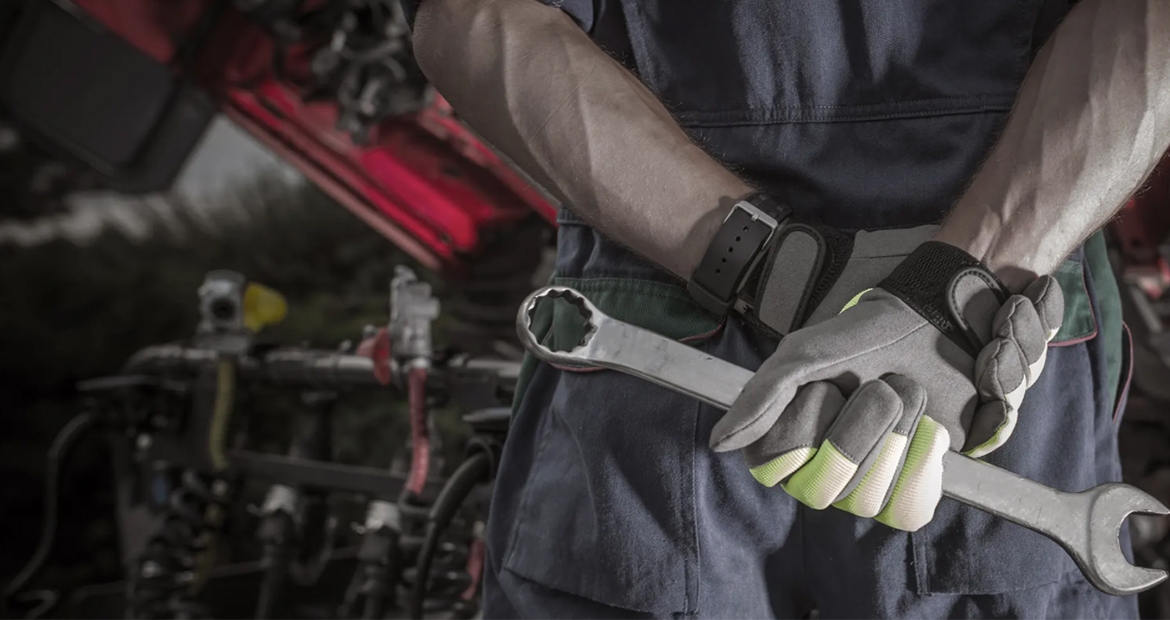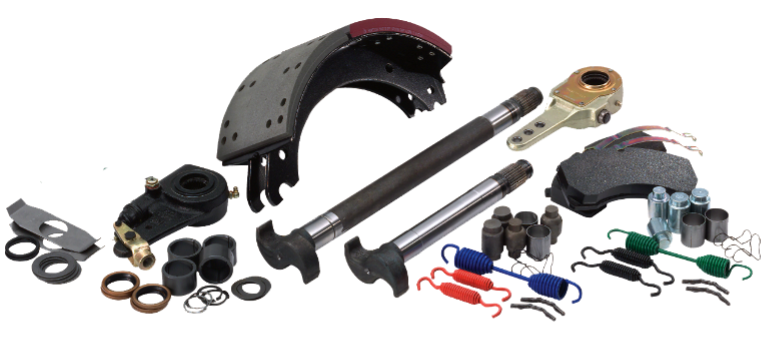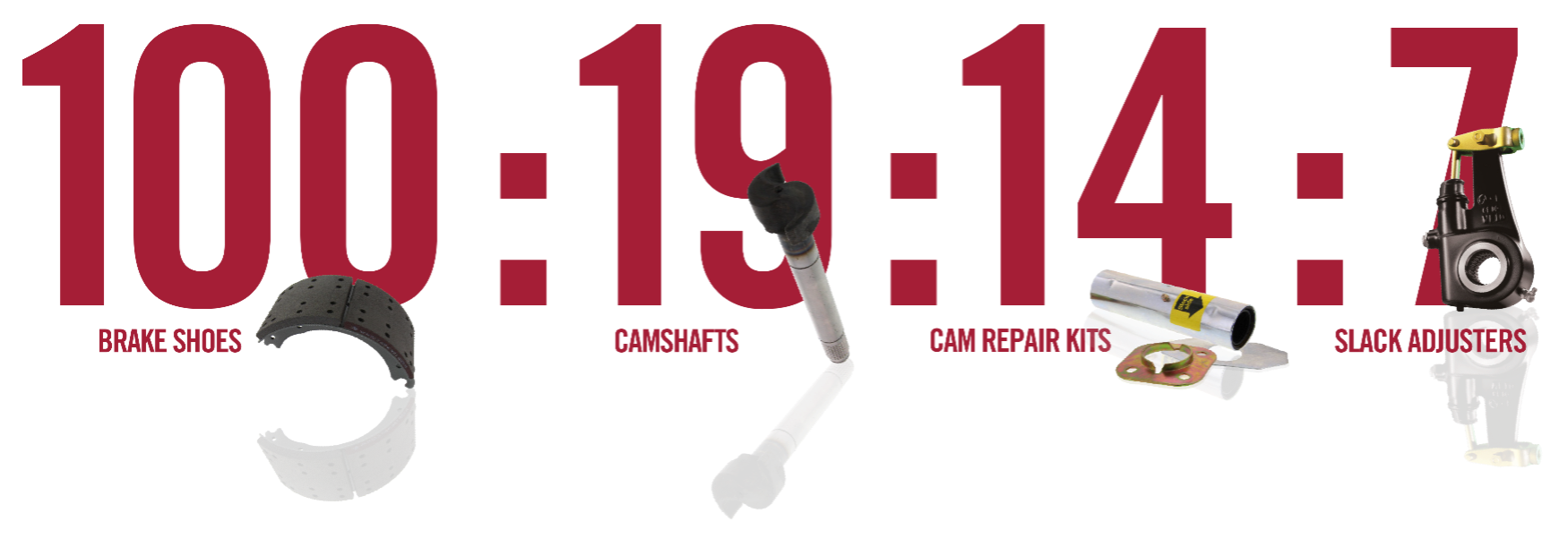Are you conducting a complete brake job?
Why it's important to inspect the entire foundation braking system during service
By Cummins Inc., Global Power Technology Leader

Brake system issues are a leading cause of out-of-service violations. When performing brake maintenance, it is important to inspect and maintain the entire braking system to prevent these violations. The goal is not to have more brake jobs, but rather for brake jobs to be more complete, resulting in more uptime.
Here are the facts:
- In 2023, there were nearly 54,207 out-of-service brake violations, according to data from the Federal Motor Carrier Safety Administration.1
- Brake systems were the cause of 25% of all May 2023 International Roadcheck inspection out-of-service violations.2
- Failure to spend money on a brake job can cost a fleet $400 in revenue for the average four hours they will be out of service plus the cost of repairs.
- Automatic slack adjusters, brake shoe lining, brake drum, camshaft and the brake chamber bracket are the top five braking components responsible for the most out-of-service citations.
- Proper brake maintenance can prevent costly roadside repairs, reduce downtime, and decrease the number of fines and enforcement penalties. Here’s a complete look at what goes into proper brake maintenance.

Automatic slack adjuster inspection
To maintain proper brake adjustment and provide balanced braking, automatic slack adjusters (ASA) must be inspected to confirm an identical ASA is used on both sides of an axle and the adjuster mechanism is functioning properly. Measure and confirm “free-stroke” is correct — the Meritor® Simple Check tool can make this measurement easier. If found to be incorrect, determine the root cause and correct it; do not just adjust the brake.
The ASA mechanism is checked using a torque wrench. For stroke sensing models, replace the ASA if the counter-clockwise rotating torque is more than 45 inch-pounds. With clearance sensing models, you need to replace the ASA if the counter-clockwise rotating torque is less than 13 foot-pounds when testing the internal clutch adjuster. Meritor offers both stroke sensing and clearance sensing ASAs.
Brake shoe and lining inspection
Check lining thickness and look for cracked linings as well as ones covered with oil, grease or fluid from a failed camshaft seal/bushing or wheel seal. When inspecting Meritor lined shoes, look for the wear indicator. For non-Meritor shoes, use the Meritor brake lining gauge.
Rust jacking occurs when harsh chemicals, such as ones used for deicing, get between the table of the shoe and the lining. The shoe coating fails, then rust forms and the lining cracks and is lifted off the table resulting in premature failure of the lined shoe.
Brake drum inspection
Start the brake drum inspection by measuring drum wear. Meritor’s drum gauge is a good way to measure worn, out of round and bell mouthing issues. The diameter of the drum should not be beyond the manufacturer’s limits. The maximum internal diameter for a 16.5-inch drum is 16.620 inches or 0.120-inch wear (0.060 inches per side). As the brake surface wears the drum mass is reduced, resulting in the brake’s inability to dissipate heat. The retained heat reduces friction material life and braking performance.
Also, check to see that no part of the drum is missing. Look for scored or heat-checked drums. Upon visual inspection, a heat-checked (cracked) brake drum will appear closed at room temperature. Heat checks open and close with each brake application. Be aware that heat checks may not necessarily be at the edge of the drum.
In addition, if you find hot spotting or scoring, replace the brake drum.
Camshaft inspection
When inspecting the camshaft look for missing or broken components such as cam rollers, springs, anchor pins and mounting bolts. Check cam bushings, cam tubes, and retaining rings. Be on the lookout for excessive wear of the camshaft head and rollers, as these can cause brake stroke fluctuations and result in exceeding the maximum range of the camshaft. Also check to see that the camshaft and camshaft tubes are properly lubricated.
Check camshaft radial movement by moving the camshaft head in all directions, and use a dial indicator to measure movement. Movement should not exceed 0.030 inches. If it does, replace the bushing and/or camshaft. Note, as radial bushing wear increases, push rod stroke also will increase.
Next, move the camshaft axially. Movement must fall with-in 0.005 inches and 0.060 inches. If it does not, add or remove washers to achieve the desired goal. Axial end play is the most overlooked root cause of brake noise.
Service chambers and spring brake inspection
The service chambers and spring brakes on each end of an axle must be the same size. Inspect to make sure push rod stroke is not greater than the industry limits. There should be no damage to the service chamber, spring brake or push rods/clevis. Service chamber or spring brakes should be fastened securely.
There are long stroke and standard stroke chambers, and it is important to know which you are working with. The Society of Automotive Engineers recommends using two of three options for identification. Long stroke chambers have a trapezoidal shaped tag, square port boss and permanent identification on the brake chamber.
The CVSA limit on a type-30 standard-stroke air brake chamber at 90 psi is 2 inches (0.66 inches is clearance between the lining and drum; 1.15 inches is taken up by brake and drum deflection; and 0.19 inches is for brake stroke reserve).
The CVSA limit on a type-30 long-stroke brake chamber at 90 psi is 2.5 inches (0.66 inches is clearance between the lining and drum; 1.15 inches is taken up by brake and drum deflection; and 0.69 inches is for brake stroke reserve).
To test the return spring, force the pushrod back when the brake is released. Release the air from the service chamber. Release the spring brake and pull the pushrod out — there should be about 40 pounds of resistance. When you let go, the pushrod should return to a full released position on its own.
Symptoms of a bad return spring include an under-adjusted ASA, uneven release, rod not returning to full release position, and dragging brakes.
Industry concerns
A major industry concern is ASAs that are out of adjustment and contributing to incorrect stroke length. To address this concern, install Meritor’s Simple Check stroke tool at the base of the chamber/spring brake. If the stroke tool is longer than the chamber stud, you need to inspect the ASA.
Another concern is brake lining thickness and cracked linings. Use a brake lining gauge to verify lining thickness. To avoid cracking and rust jacking, use shoes that feature Meritor’s PlatinumShield® III.
Missing or broken components on camshafts are another concern. Regular inspection of camshaft bushings or camshaft tube enclosures will allow you to spot problems early.

Calculate your ratio
As a recognized leading global supplier of brakes, Meritor has identified an estimated ratio of related service items that fleet operations should service during a preventative maintenance program. The Meritor ratio addresses 4 of the top 5 braking components for the most out-of-service citations, which includes brake shoes (kits), camshafts, camshaft repair kits, and slack adjusters. Want to find out if you are conducting a complete brake job? Use the interactive calculator on MeritorPartsXpress.com for a customized report to determine if your ratio is HIGHER or LOWER and if you could make adjustments to your preventative maintenance practices.
1 In 2023, Brakes Out of Service (396.3A1BOS) was the #2 out-of-service violation with 54,207 violations for all vehicles.
(Data source: FMCSA’s Motor Carrier Management Information System (MCMIS))
2 During May 2023 International Roadcheck, a total of 59,429 Inspections were conducted in North America resulting in 4,412 out-of-service vehicle violations attributed to brake systems.
Author Profiles

Cummins Inc., Global Power Technology Leader
Cummins Inc., a global power leader, is committed to powering a more prosperous world. Since 1919, we have delivered innovative solutions that move people, goods and economies forward. Our five business segments—Engine, Components, Distribution, Power Systems and Accelera™ by Cummins—offer a broad portfolio, including advanced diesel, alternative fuel, electric and hybrid powertrains; integrated power generation systems; critical components such as aftertreatment, turbochargers, fuel systems, controls, transmissions, axles and brakes; and zero-emissions technologies like battery and electric powertrain systems and electrolyzers. With a global footprint, deep technical expertise and an extensive service network, we deliver dependable, cutting-edge solutions tailored to our customers’ needs, supporting them through the energy transition with our Destination Zero strategy. We create value for customers, investors and employees and strengthen communities through our corporate responsibility global priorities: education, equity and environment. Headquartered in Columbus, Indiana, Cummins employs approximately 70,000 people worldwide and earned $3.9 billion on $34.1 billion in sales in 2024.
Related Topics
Related Tags